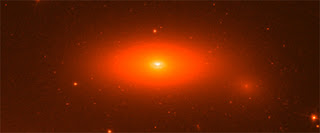The supermassive black holes occupying the centers of most galaxies have a close relationship with their galactic hosts. Galaxies with large central bulges have massive black holes, while the relatively lightweight black holes live in galaxies with smaller bulges. This link has been observed in enough cases to raise it nearly to a principle: black holes and galactic bulges grow together, as part of a single process.
A new observation has revealed a galaxy that isn't just bending the rule, but completely breaking it. In most systems, the black hole's mass is about 0.1 percent of the mass of the galaxy's central bulge. Remco van den Bosch and colleagues identified a black hole with a mass that's about 59 percent of the mass of the central bulge. In fact, this black hole is one of the most massive ever observed, a striking discovery in a galaxy much smaller than our own. The galaxy itself is a bit on the small side, and the researchers suggest that we might want to look at the black holes in more galaxies this size.
Ars Technica:
Violates established relationship between black holes, galactic bulges masses.
**********
Fort Davis, Texas — Astronomers have used the Hobby-Eberly Telescope at The University of Texas at Austin's McDonald Observatory to measure the mass of what may be the most massive black hole yet — 17 billion Suns — in galaxy NGC 1277. The unusual black hole makes up 14 percent of its galaxy's mass, rather than the usual 0.1 percent. This galaxy and several more in the same study could change theories of how black holes and galaxies form and evolve. The work will appear in the journal Nature on Nov. 29.
NGC 1277 lies 220 million light-years away in the constellation Perseus. The galaxy is only ten percent the size and mass of our own Milky Way. Despite NGC 1277's diminutive size, the black hole at its heart is more than 11 times as wide as Neptune's orbit around the Sun.
McDonald Observatory:
Using Hobby-Eberly Telescope


Comments